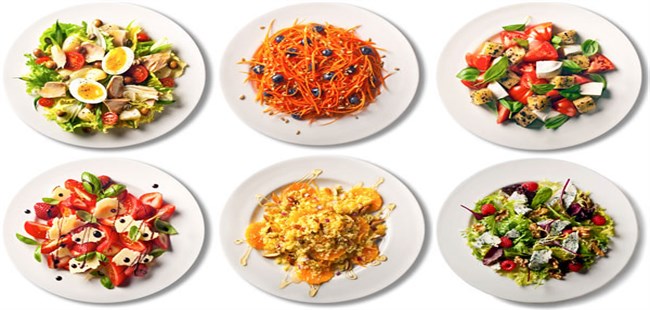Salads form an essential part of our diet, whether they are simple side dishes or substantial main courses. Fresh, nutritious ingredients, served raw or lightly cooked, make a colorful, attractive dish to stimulate the appetite.
Using Basic Ingredients
Be creative with salad ingredients, and use of a simple salad, or create interesting main fresh flavors, colors, and textures to the courses by combining lots of salad ingredients, fullest. Use a variety of greens to make the most Match ingredients with dressings to your taste.
Draining Salads
Using a saucer
Place an upside-down saucer in the bottom of a salad bowl before adding the salad. Excess water and dressing will gather underneath the saucer, keeping the salad leaves crisp.
Presenting Leaves
• Using whole leaves: Use crisp, whole lettuce leaves, such as romaine or iceberg, as natural serving dishes.
• Cutting wedges: To produce interesting shapes and texture in a green salad, thinly slice an iceberg lettuce into wedges.
• Lifting out a core: To remove the central core from an iceberg lettuce while keeping the leaves whole, slam the lettuce firmly, stem end down, onto a countertop. The core should then be loose enough to be lifted out by hand.
• Removing bitterness: To avoid a bitter flavor in chicory, cut out the core at the stem end.
Sprouting Beans
Soaking Beans In A Jar
Sprouting beans or other whole beans for use in salads. Put them in a large jar and soak overnight. Drain, cover the jar with cheesecloth and rinse twice a day until the beans sprout.
Improving Ingredients
• Cucumber: Before adding a sliced cucumber to salad, sprinkle the pieces with salt, and let drain for about 20 minutes to remove excess moisture. Rinse and dry.
• Onions: To prevent the strong flavor of onions from dominating a salad, let the cut onion soak in cold water for one hour before use.
• Tomatoes: Add interest to a tomato salad by mixing beefsteak, sun-dried, and cherry tomatoes. Sprinkle with olive oil as a dressing.
• Celery: Keep leftover celery fresh for reuse by trimming and standing in chilled water.
Making Rice Timbales
Shaping Rice
Toss cooked rice in a dressing, then pack firmly into coffee or tea cups, or into a small bundt pan. Invert the cups onto a serving dish, and unmold for attractively shaped rice salads.
Flavoring Warm Salads
Adding vinegar: Sprinkle warm salad ingredients with a few drops of an aged vinegar, such as balsamic or sherry vinegar. The warmth of the salad will bring out the full flavor of the vinegar.
Using sesame oil: Give a Far Eastern flavor to a warm salad by adding a teaspoon of sesame oil to the dressing. Cooking shallots Simmer finely chopped shallots slowly in a few tablespoonfuls of red wine vinegar until soft. Toss them into a potato or bean salad for a warm, rich flavor.
Adding Variety
Combine common and unusual ingredients to make imaginative and appetizing salads. Mix crunchy ingredients, such as croutons and seeds, with soft textures, such as fresh and dried fruits. Contrast sharp flavors with mild ones, and use herbs to add a distinctive flavor.
Enhancing Salads
• Adding anchovies: Stir a few finely chopped canned anchovies into a potato salad.
• Using herbs: Scatter generous amounts of fresh, chopped herbs, such as parsley, chervil, or chives, into a plain green salad, or add arugula for a peppery bite.
• Adding texture: To add a crunchy texture to a simple salad, stir in a handful of toasted sunflower or sesame seeds, flaked almonds, or even salted peanuts just before serving the salad.
• Shaving: Parmesan Scatter curled shavings of Parmesan cheese onto a plain salad.
Making Mixed Salads Adding Garnishes
Layering Ingredients
Pour dressing into a straight-sided bowl, and place layers of colorful mixed salad vegetables into it. Turn the filled bowl over onto a serving dish for a dressed salad.
Making Croutons
To add a crunchy garnish to a simple salad, use croutons. Cut shapes from sliced bread with a small cutter. Gently fry the shapes in oil until golden, toss with parsley, and add to salad.
Making Dressings
A well-balanced, freshly made dressing can add a subtle or a distinctive flavor to a salad. Classic recipes, such as vinaigrette, are a good starting point, but imaginative dressings can be created using flavored vinegar and oils, fruit juices, herbs, spices, seeds, and zests.
Combining Ingredients
• Dressing warm ingredients: Dress rice or pasta salads while they are still slightly warm so that they absorb the flavors of the dressing.
• Adding nut oils: Enhance salad dressings by using nut oils, such as walnut or hazelnut, for a rich flavor.
• Lowering fat: Use plain yogurt or milk, instead of oil, as a basis for a low-fat dressing.
• Sweetening dressings: If you find vinegar-based dressings too sharp, substitute apple or orange juice for the vinegar, or add a teaspoonful of honey.
• Adding cheese: Use ripe Stilton or Roquefort for a blue- cheese dressing. Mash cheese with a fork, and stir into light cream or mayonnaise.
Making Vinaigrette
Using a screw-top jar
To make vinaigrette quickly, pour vinegar, or lemon juice, and oil into a straight-sided, screw-top jar. Use three parts oil to one part vinegar, or four or five parts oil to one part lemon juice. Shake die jar to mix the ingredients.
A Good Idea
Using a mustard jar: When a mustard jar is almost empty, leave the last scrapings in the jar, and use it to make a salad dressing. Measure the other ingredients into the jar, and shake well. The remaining mustard will flavor the dressing.






